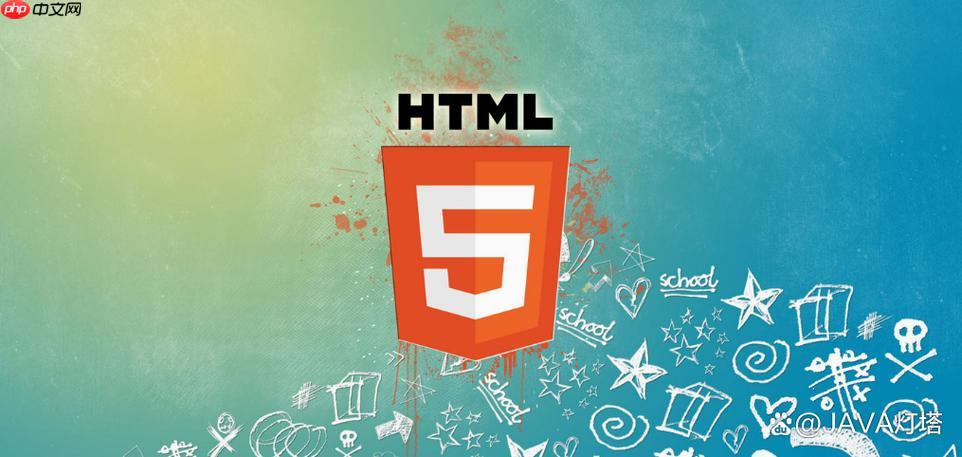单纯的html无法独立实现日历提醒和事件通知弹出,必须结合javascript和css;2. javascript负责日期计算、事件管理、提醒检测及通知触发;3. 使用web notification api可实现系统级通知,但需用户授权且样式受限;4. 当原生通知不可用时,可通过html/css构建自定义弹窗,配合javascript控制显示与交互;5. 用户友好的事件管理需提供添加、编辑、删除功能,结合表单与dom操作实现动态更新;6. 日历渲染需根据当前月份生成日期格子,并标记有事件的日期;7. 提醒机制通过定时检查事件时间,匹配时触发通知并标记已提醒;8. 自定义弹窗可通过遮罩层和居中内容区实现,支持丰富样式与交互;9. 最终方案需综合html结构、css美化与javascript逻辑,确保功能完整与用户体验流畅。

要在HTML页面中制作日历提醒和事件通知弹出,单纯的HTML是无法独立完成的。它更像是一个骨架,真正赋予它生命和交互能力的,是JavaScript和CSS。说白了,HTML负责内容结构,CSS负责美化,而JavaScript才是那个让日历动起来、让提醒弹出来的“大脑”。所以,核心思路就是利用JavaScript来处理日期逻辑、事件存储、时间检测,并调用浏览器提供的通知API或自定义UI来展示提醒。
制作一个功能性的网页日历提醒,主要涉及到以下几个层面:
div
具体步骤分解:
立即学习“前端免费学习笔记(深入)”;
HTML结构:
<div id="calendar-container">
<div id="calendar-header">
<button id="prev-month">上月</button>
<h2 id="current-month-year"></h2>
<button id="next-month">下月</button>
</div>
<div id="calendar-grid">
<!-- 日期格子将由JS生成 -->
</div>
</div>
<!-- 自定义弹窗结构(如果不用原生通知) -->
<div id="custom-notification-modal" style="display:none;">
<div class="modal-content">
<span class="close-button">×</span>
<h3 id="notification-title"></h3>
<p id="notification-description"></p>
</div>
</div>JavaScript核心逻辑(简化版):
const calendarGrid = document.getElementById('calendar-grid');
const currentMonthYear = document.getElementById('current-month-year');
let currentDate = new Date(); // 当前日期对象
// 假设的事件数据
let events = [
{ date: '2024-07-15', time: '10:00', title: '项目会议', description: '讨论Q3规划' },
{ date: '2024-07-20', time: '14:30', title: '客户拜访', description: '洽谈新合同' }
];
// 渲染日历(简化,实际需要复杂逻辑处理每月天数、星期等)
function renderCalendar() {
calendarGrid.innerHTML = ''; // 清空旧日历
currentMonthYear.textContent = currentDate.toLocaleString('zh-CN', { month: 'long', year: 'numeric' });
// 模拟生成几天,实际需要根据月份生成所有天
for (let i = 1; i <= 31; i++) {
const dayDiv = document.createElement('div');
dayDiv.classList.add('calendar-day');
dayDiv.textContent = i;
// 检查是否有事件,并添加标记
const currentDayFormatted = `${currentDate.getFullYear()}-${(currentDate.getMonth() + 1).toString().padStart(2, '0')}-${i.toString().padStart(2, '0')}`;
if (events.some(event => event.date === currentDayFormatted)) {
dayDiv.classList.add('has-event'); // 添加CSS类来标记有事件的日期
dayDiv.title = events.filter(event => event.date === currentDayFormatted).map(e => e.title).join(', ');
}
calendarGrid.appendChild(dayDiv);
}
}
// 检查提醒并触发通知
function checkReminders() {
const now = new Date();
events.forEach(event => {
const eventDateTime = new Date(`${event.date}T${event.time}:00`);
// 假设提前5分钟提醒
const reminderTime = new Date(eventDateTime.getTime() - 5 * 60 * 1000);
if (now >= reminderTime && now < eventDateTime) { // 提醒时间已到,且事件未开始
// 确保只提醒一次,可以标记事件为已提醒
if (!event.reminded) {
triggerNotification(event.title, event.description);
event.reminded = true; // 标记为已提醒
}
}
});
}
// 触发通知函数
function triggerNotification(title, body) {
// 优先使用浏览器原生通知
if ('Notification' in window) {
Notification.requestPermission().then(permission => {
if (permission === 'granted') {
new Notification(title, { body: body, icon: 'icon.png' });
} else {
// 如果用户拒绝,退而求其次使用自定义弹窗
showCustomModal(title, body);
}
});
} else {
// 浏览器不支持Notification API,直接使用自定义弹窗
showCustomModal(title, body);
}
}
// 显示自定义弹窗
function showCustomModal(title, description) {
const modal = document.getElementById('custom-notification-modal');
document.getElementById('notification-title').textContent = title;
document.getElementById('notification-description').textContent = description;
modal.style.display = 'block'; // 显示弹窗
// 绑定关闭按钮事件
document.querySelector('.close-button').onclick = () => {
modal.style.display = 'none';
};
}
// 初始化
renderCalendar();
// 每分钟检查一次提醒
setInterval(checkReminders, 60 * 1000);一个用户友好的事件管理界面,不单单是把日历画出来,更重要的是让用户能够轻松地添加、编辑、查看和删除事件。这涉及到一些UI/UX的考量和前端交互的实现。我个人觉得,核心在于直观和反馈。
首先,事件的添加。最常见的做法是提供一个表单。这个表单可以是一个浮动弹窗,也可以是日历下方的一个固定区域。表单里至少得有事件标题、日期选择器(
<input type="date">
<input type="time">
<textarea>
events
其次,事件的查看和编辑。当用户点击日历上某个有事件的日期时,应该能看到该日期的所有事件列表。如果点击列表中的某个事件,可以弹出一个详情页或编辑表单,让用户修改事件信息或者删除它。这种“点击-弹出-操作”的模式,用户体验会比较流畅。你可以考虑给有事件的日期格子加上一个特定的CSS类,比如
has-event
再者,导航和反馈。日历的月份切换按钮(“上月”、“下月”)是必须的,要确保切换时日历内容能正确地重新渲染。当用户成功添加或修改事件后,给一个简单的视觉反馈,比如短暂的提示消息(“保存成功!”),或者让新添加的事件在日历上闪烁一下,这样用户会感觉系统是有响应的,而不是“死”的。
至于技术实现,这一切都离不开JavaScript对DOM(文档对象模型)的操作。你需要编写函数来:
events
events
events
// 假设事件添加表单的HTML
/*
<form id="event-form">
<input type="text" id="event-title-input" placeholder="事件标题" required>
<input type="date" id="event-date-input" required>
<input type="time" id="event-time-input" required>
<textarea id="event-description-input" placeholder="事件描述"></textarea>
<button type="submit">添加事件</button>
</form>
*/
// JavaScript添加事件的简化逻辑
document.getElementById('event-form').addEventListener('submit', function(e) {
e.preventDefault(); // 阻止表单默认提交行为
const title = document.getElementById('event-title-input').value;
const date = document.getElementById('event-date-input').value;
const time = document.getElementById('event-time-input').value;
const description = document.getElementById('event-description-input').value;
if (title && date && time) {
events.push({ date, time, title, description, reminded: false }); // 新事件未提醒
renderCalendar(); // 重新渲染日历以显示新事件
this.reset(); // 清空表单
alert('事件添加成功!'); // 简单反馈
} else {
alert('请填写所有必填项!');
}
});这种模式能让用户对日历的掌控感更强,也更容易上手。
浏览器原生通知(Web Notification API)是现代浏览器提供的一个非常棒的功能,它允许网页在用户不聚焦当前页面时,甚至在浏览器最小化或关闭时(如果结合Service Worker),向用户发送系统级的通知。这玩意儿用起来,感觉就像是操作系统自带的提醒,非常酷。
典型使用场景:
它的优势在于:
然而,Web Notification API也有其局限性,用的时候得琢磨琢磨:
总的来说,Web Notification API是实现系统级提醒的利器,但它的使用需要尊重用户隐私和体验,并且要清楚其能力边界。
有时候,浏览器原生的通知API确实不那么“得心应手”,比如你想要一个高度定制化的弹窗样式,或者希望弹窗内有更复杂的交互逻辑,再或者用户就是不给通知权限。这时候,我们就可以退而求其次,或者说,是“主动选择”——构建一个完全由HTML、CSS和JavaScript控制的自定义网页弹窗。我个人觉得,这种方式虽然不如原生通知“高级”,但它能给你带来无限的自由度。
为什么选择自定义弹窗?
构建自定义弹窗的核心思路:
HTML结构: 通常由两层构成。一层是半透明的“遮罩层”(overlay),覆盖整个页面,用来阻止用户与下方内容的交互,并突出弹窗。另一层是“弹窗内容区”,位于遮罩层上方,包含标题、正文和操作按钮等。
<div id="custom-alert-overlay" class="modal-overlay">
<div class="modal-content">
<span class="close-btn">×</span>
<h3 id="alert-title"></h3>
<p id="alert-message"></p>
<button class="action-btn">好的,知道了</button>
</div>
</div>CSS样式: 这是自定义弹窗的灵魂。
position: fixed; top: 0; left: 0; width: 100%; height: 100%; background-color: rgba(0,0,0,0.6); z-index: 1000; display: none;
display: none
z-index
position: fixed; top: 50%; left: 50%; transform: translate(-50%, -50%); background-color: white; padding: 20px; border-radius: 8px; box-shadow: 0 4px 12px rgba(0,0,0,0.2); z-index: 1001;
transform
position: absolute; top: 10px; right: 10px; cursor: pointer;
.modal-overlay {
position: fixed;
top: 0;
left: 0;
width: 100%;
height: 100%;
background-color: rgba(0, 0, 0, 0.6); /* 半透明黑色背景 */
display: flex; /* 使用flexbox居中内容 */
justify-content: center;
align-items: center;
z-index: 1000; /* 确保在最上层 */
visibility: hidden; /* 默认隐藏,使用visibility和opacity做动画 */
opacity: 0;
transition: opacity 0.3s ease, visibility 0.3s ease;
}
.modal-overlay.show {
visibility: visible;
opacity: 1;
}
.modal-content {
background-color: white;
padding: 30px;
border-radius: 8px;
box-shadow: 0 5px 15px rgba(0, 0, 0, 0.3);
max-width: 400px;
width: 90%;
position: relative;
transform: translateY(-20px); /* 初始位置稍微偏上,做动画用 */
transition: transform 0.3s ease;
}
.modal-overlay.show .modal-content {
transform: translateY(0); /* 弹入效果 */
}
.close-btn {
position: absolute;
top: 10px;
right: 15px;
font-size: 24px;
cursor: pointer;
color: #aaa;
}
.close-btn:hover {
color: #333;
}JavaScript逻辑: 负责控制弹窗的显示与隐藏,以及处理内部的交互。
const overlay = document.getElementById('custom-alert-overlay');
const alertTitle = document.getElementById('alert-title');
const alertMessage = document.getElementById('alert-message');
const closeButton = overlay.querySelector('.close-btn');
const actionButton = overlay.querySelector('.action-btn');
function showCustomAlert(title, message) {
alertTitle.textContent = title;
alertMessage.textContent = message;
overlay.classList.add('show'); // 添加class来显示弹窗
document.body.style.overflow = 'hidden'; // 阻止页面滚动
}
function hideCustomAlert() {
overlay.classList.remove('show'); // 移除class来隐藏弹窗
document.body.style.overflow = ''; // 恢复页面滚动
}
// 绑定关闭事件
closeButton.addEventListener('click', hideCustomAlert);
actionButton.addEventListener('click', hideCustomAlert);
// 点击遮罩层关闭(可选)
overlay.addEventListener('click', function(e) {
if (e.target === overlay) { // 确保点击的是遮罩层本身,而不是弹窗内容
hideCustomAlert();
}
});
// 可以在需要时调用 showCustomAlert('提醒', '您的会议即将开始!');
// 替换 triggerNotification 中的 showCustomModal
// function showCustomModal(title, description) { showCustomAlert(title, description); }通过这种方式,你可以完全掌控提醒弹窗的每一个细节,让它更好地融入你的网页设计,并提供更丰富的用户交互。当然,这种自定义弹窗需要你投入更多的精力去设计和实现其样式和行为,但其带来的灵活性是原生通知无法比拟的。
以上就是HTML如何制作日历提醒?事件通知怎么弹出?的详细内容,更多请关注php中文网其它相关文章!

HTML怎么学习?HTML怎么入门?HTML在哪学?HTML怎么学才快?不用担心,这里为大家提供了HTML速学教程(入门课程),有需要的小伙伴保存下载就能学习啦!

Copyright 2014-2025 https://www.php.cn/ All Rights Reserved | php.cn | 湘ICP备2023035733号